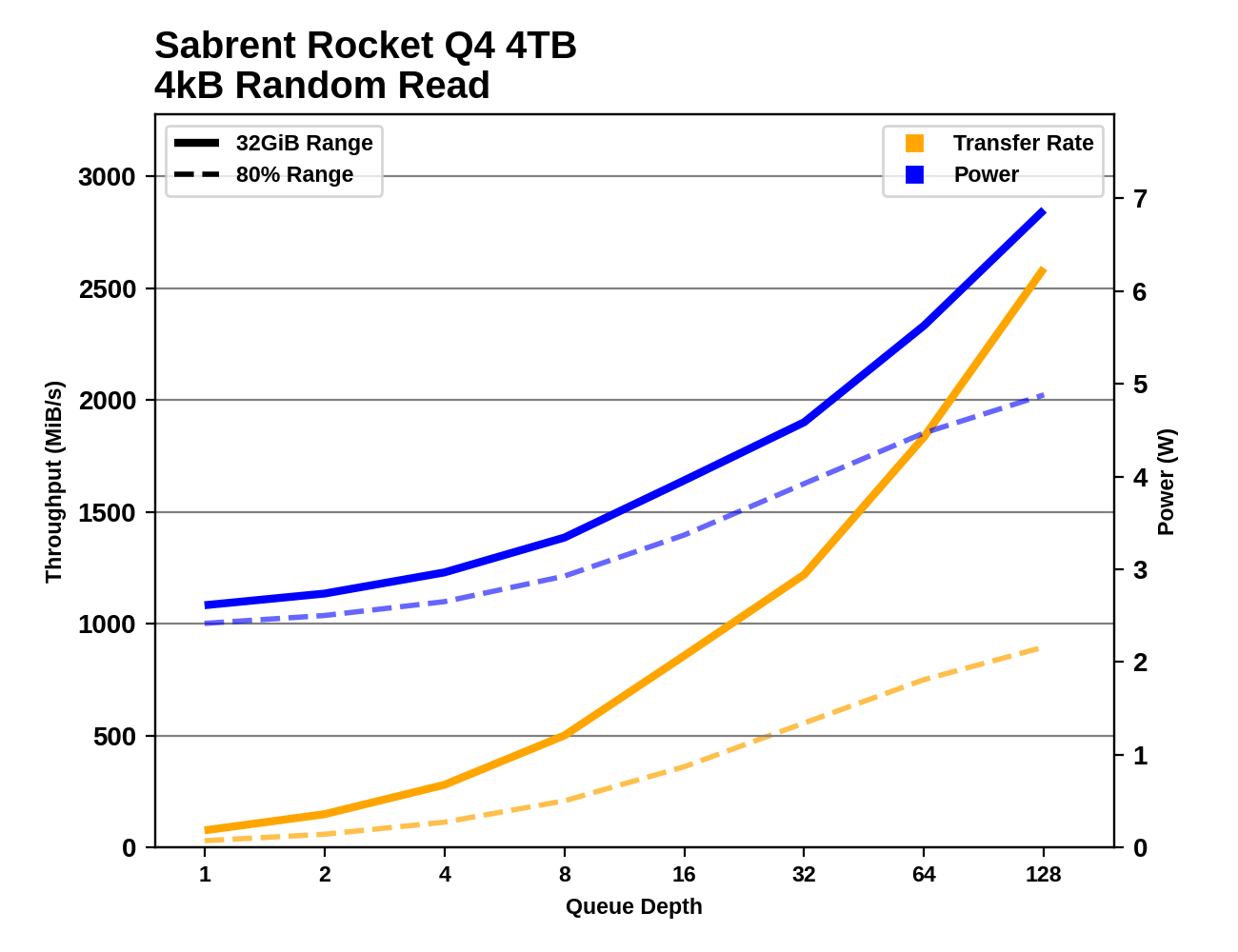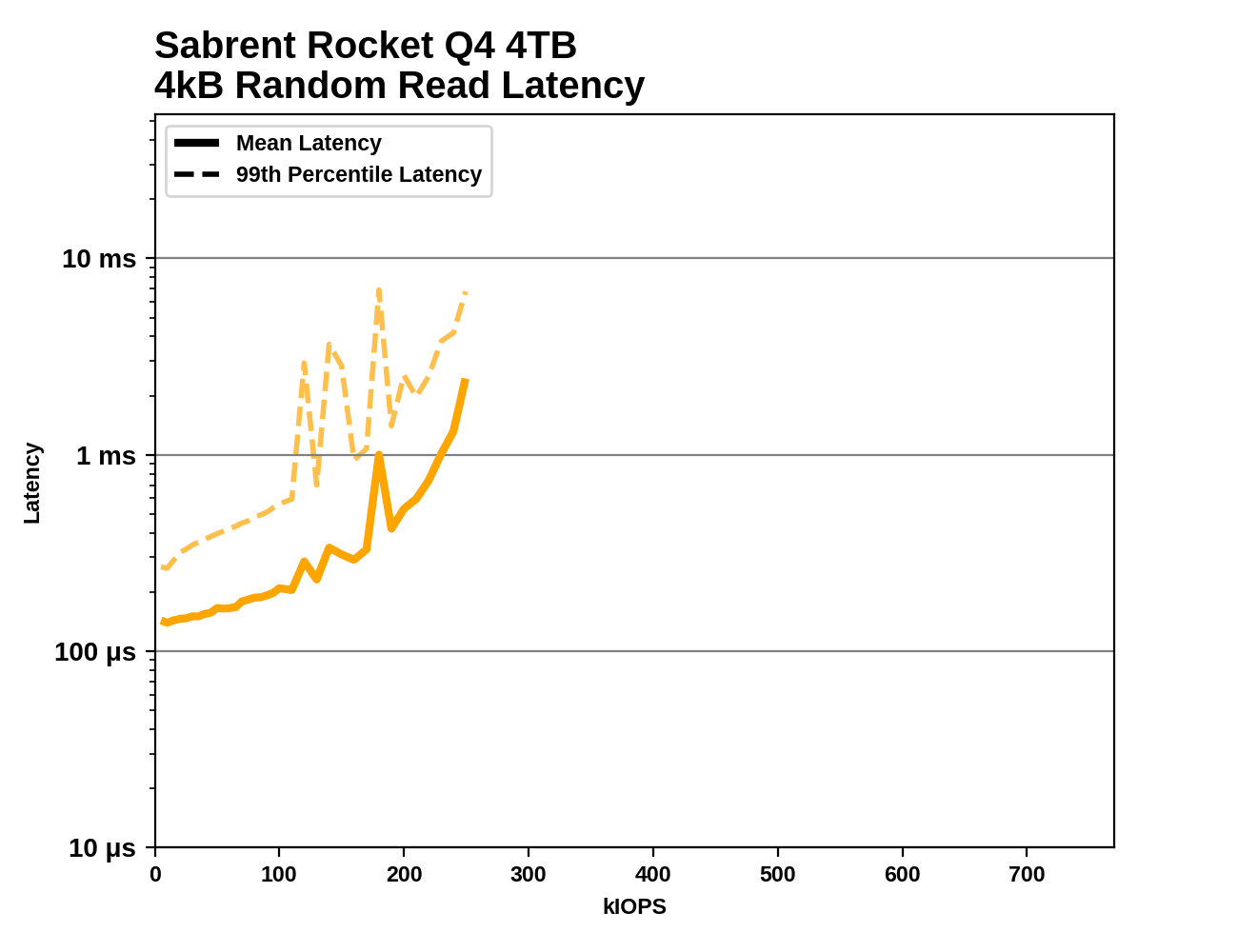Sabrent Rocket Q4 and Corsair MP600 CORE NVMe SSDs Reviewed: PCIe 4.0 with QLC
by Billy Tallis on April 9, 2021 12:45 PM ESTBurst IO Performance
Our burst IO tests operate at queue depth 1 and perform several short data transfers interspersed with idle time. The random read and write tests consist of 32 bursts of up to 64MB each. The sequential read and write tests use eight bursts of up to 128MB each. For more details, please see the overview of our 2021 Consumer SSD Benchmark Suite.
 |
|||||||||
| Random Read | Random Write | ||||||||
| Sequential Read | Sequential Write | ||||||||
The random read performance from the SLC caches on the Rocket Q4 and MP600 CORE are plenty fast, albeit still not able to match the Intel SSD 670p. Outside the cache, the two Phison E16 QLC drives are definitely slower than mainstream TLC drives, but their performance is fine by QLC standards.
For short bursts of writes that don't overflow the SLC cache, these drives are very fast and their caches are still useful even when the drive as a whole is 80% full.
As is often the case for Phison-based drives, the low queue depth sequential read performance is still not great, but sequential writes are very fast and do reach PCIe Gen4 speeds.
Sustained IO Performance
Our sustained IO tests exercise a range of queue depths and transfer more data than the burst IO tests, but still have limits to keep the duration somewhat realistic. The primary scores we report are focused on the low queue depths that make up the bulk of consumer storage workloads. For more details, please see the overview of our 2021 Consumer SSD Benchmark Suite.
 |
|||||||||
| Random Read | Throughput | Power | Efficiency | ||||||
| Random Write | Throughput | Power | Efficiency | ||||||
| Sequential Read | Throughput | Power | Efficiency | ||||||
| Sequential Write | Throughput | Power | Efficiency | ||||||
The random read performance from the Rocket Q4 and MP600 CORE is greatly improved over the earlier Phison E12 QLC SSDs, at least when the test is hitting a narrow slice of the drive that should be entirely within the SLC cache. Random and sequential write results are both decent given that these are in many ways still low-end drives. These two drives are large enough (and have enough SLC cache) to handle much larger bursts of writes than 1TB models, even when the drives are 80% full.
 |
|||||||||
| Random Read | |||||||||
| Random Write | |||||||||
| Sequential Read | |||||||||
| Sequential Write | |||||||||
The E16-based QLC drives are able to continue scaling up random read throughput (from the SLC cache, at least) long past the points where other QLC drives hit a performance wall. The 4TB Rocket Q4 scales better than the 2TB MP600 CORE, and by QD128 it is handling random reads at 2.5GB/s and still has headroom for more performance. For random writes, the Rocket Q4 and MP600 CORE saturate around QD4 or a bit later, which is fairly typical behavior.
When testing sequential reads, we get the characteristic behavior from Phison controllers: poor throughput until around QD16 or so, at which point there's enough data in flight at any given time to allow the SSD controller to stay properly busy. The sequential write results are messy since both drives run out of SLC cache frequently during this test, and that makes it hard to identify what the performance limits would be in more favorable conditions. But it appears that sequential write speed is saturating around QD2, and stays flat with increasing queue depth except when the caching troubles come up.
Random Read Latency
This test illustrates how drives with higher throughput don't always offer better IO latency and Quality of Service (QoS), and that latency often gets much worse when a drive is pushed to its limits. This test is more intense than real-world consumer workloads and the results can be a bit noisy, but large differences that show up clearly on a log scale plot are meaningful. For more details, please see the overview of our 2021 Consumer SSD Benchmark Suite.
 |
|||||||||
The Sabrent Rocket Q4 and Corsair MP660 CORE show better latency on this test than the other low-end NVMe drives, but all the mainstream TLC drives with DRAM have clear advantages. Even the Samsung 870 EVO has lower latency until it gets close to saturating the SATA link. Between the 2TB MP600 CORE and the 4TB Rocket Q4, the larger drive unsurprisingly can sustain higher random read throughput and its latency climbs more gradually, but the Rocket Q4 does have more transient latency spikes along the way.










60 Comments
View All Comments
ZolaIII - Friday, April 9, 2021 - link
What's the purpose of those? I mean I recently bought MP600 1 TB for the price of MP600 Core same capacity. I didn't bought it for it's speed but it's TBW endurance which is by the way twice as MP600 Core 4GB.This doesn't have any market place in my opinion when you can buy a drive with same controller and same 96 layer but TCL NAND for a same price or just a little bit more money.
SarahKerrigan - Friday, April 9, 2021 - link
Yeah, right now really the only sweet spot for QLC is at 4TB.powerarmour - Saturday, April 10, 2021 - link
Absolutely, enough with this anti-consumer QLC junk. There needs to be a better tech solution that doesn't trade performance for density's sake, a better balance would be more ideal.Oxford Guy - Sunday, April 11, 2021 - link
'that doesn't trade performance for density's sake'Performance, value (by harming TLC's economy of scale), and longevity.
30% density increase for twice as many voltage states is not a great bargain.
ballsystemlord - Saturday, April 10, 2021 - link
A pig with lipstick on is still a pig. QLC is currently a pig.It ->still<- has huge leaps and bounds to go for before it becomes a viable SSD storage medium.
Oxford Guy - Sunday, April 11, 2021 - link
There are no leaps and bounds for it.The one thing that made TLC good enough was the transition from planar to 3D manufacturing.
QLC has no such saving grace in store – that's my bet.
arashi - Sunday, April 11, 2021 - link
4D manufacturing /s0ldman79 - Saturday, April 17, 2021 - link
With enough channels QLC and 4TB+ drives could work.SLC cache, QLC long term storage and 8-16 channels, that could work.
Honestly for longevity and performance I'm not sure QLC is going to beat out TLC unless they get QLC up to TLC's endurance and speed, which is likely not financially viable even if technically possible.
GeoffreyA - Sunday, April 11, 2021 - link
They're trying to pull the wool over people's eyes and sell margarine at the price of butter, hoping nobody notices.dickeywang - Sunday, April 11, 2021 - link
Unfortunately, the market isn't driven by consumers who can tell the difference between QLC and TLC. Most of the time, consumers just want to have larger capacity with lower prices. If it is the garbage they want, it is what they get. That's the sad story of capitalism.